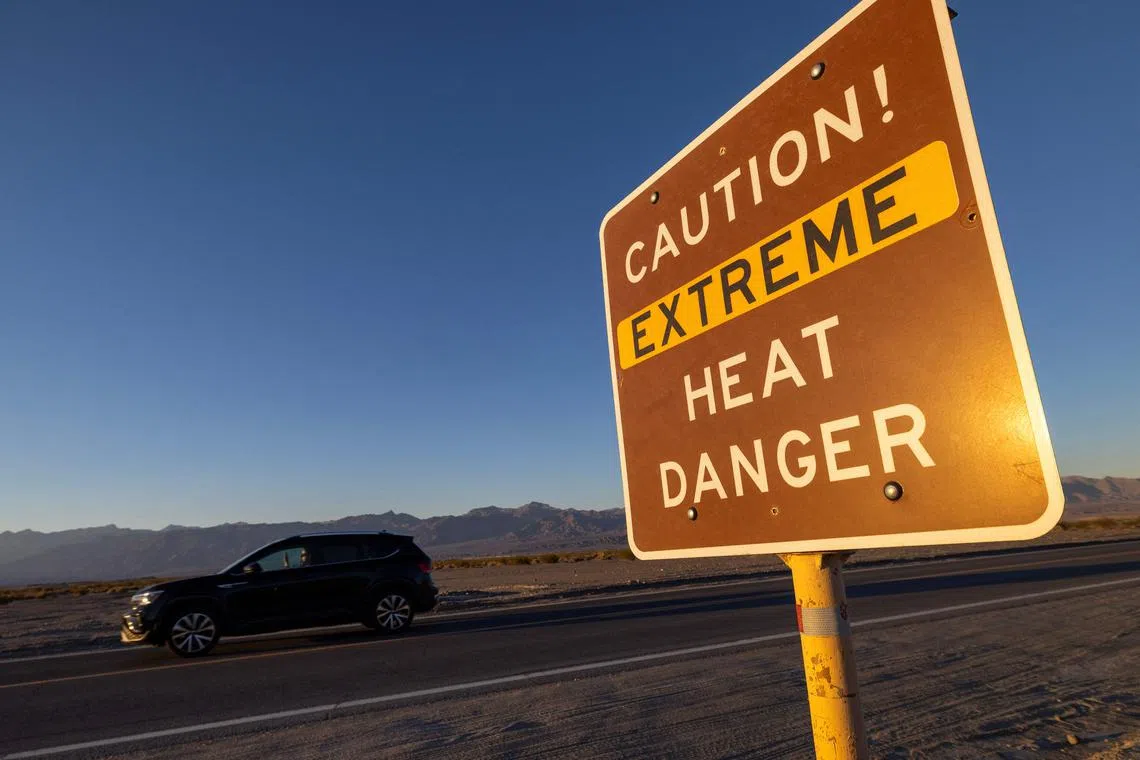‘Oppressive’ heatwave scorches US west and south
Sign up now: Get ST's newsletters delivered to your inbox

California’s famous Death Valley, one of the hottest places on Earth, had reached a life-threatening 51 deg C.
PHOTO: AFP
Follow topic:
LOS ANGELES - Swathes of the United States home to more than 80 million people were under heat warnings or advisories on Sunday, as relentless, record-breaking temperatures continued to bake western and southern states.
The National Weather Service (NWS) warned of “a widespread and oppressive heatwave” in parts of the South-west, western Gulf Coast and southern Florida, with sizzling temperatures carrying into this week and raising health risks for millions.
Southern Californians, who saw thermometers peak at 40.5 deg C to 43.3 deg C last Saturday, faced a second day of similarly brutal temperatures on Sunday, with the mercury expected to top 46.1 deg C in parts of California, Nevada and Arizona, the NWS said.
By Saturday afternoon, California’s famous Death Valley, one of the hottest places on Earth, had reached a life-threatening 51 deg C. Early afternoon temperatures on Sunday were hovering around 47.7 deg C, amid forecasts that it could reach up to 56 deg C.
Tourists visited the national park to get a glimpse of what the NWS warned would be “life-threatening daytime heat” set to last until Tuesday night.
Visitor Eliana Luna told broadcaster MSNBC on Sunday that the heat felt like a “burning sensation” on her body. “The heat, you can feel it dripping through the back, all the way down.”
The day before, the town of Idyllwild, east of Los Angeles and some 1,645m above sea level, blew past its previous record to hit 37.7 deg C.
Imperial in California tied its daily record of 46.6 deg C. Sunday’s high was forecast at 45.5 deg C.
The NWS has said heat is the leading weather-related killer in the US,and urged Americans to take the risk seriously.
“In total, from South Florida and the Gulf Coast to the South-west, over 80 million people remain under either an excessive heat warning or heat advisory as of early this morning,” the NWS said in a Sunday morning bulletin.
The authorities have been sounding the alarm for days, advising people to avoid outdoor activities in the daytime and to avoid dehydration, which can quickly become fatal in such temperatures.
In Arizona, the state capital Phoenix has recorded 16 straight days above 42 deg C, as temperatures hit 47.7 deg C last Saturday and stayed above 32 deg C overnight. The mercury climbed again on Sunday afternoon to 42.7 deg C.
The city, home to more than 1.6 million people, is under an excessive heat warning until Wednesday evening, according to the NWS.
Volunteers have been organised to direct Phoenix residents to cooling centres and distribute bottles of water and hats, but programme head David Hondula told the local ABC station that its schedule of three days per week is “clearly not enough”.
In Miami, the NWS on Sunday issued its first-ever excessive heat warning for the region, in effect until 7pm, as heat and humidity mixed to create a “feels-like” temperature expected to hit 44.4 deg C.

A construction worker takes a sip of water while repairing a road that was damaged from the heat in Houston, Texas, on June 27, 2023.
PHOTO: AFP
At a Texas construction site outside Houston last Friday, a 28-year-old worker who gave his name only as Juan struggled in the blazing heat. “Just when I take a drink of water, I get dizzy, I want to vomit because of the heat,” he said.
Residents of the metropolis were asked to conserve electricity from 2pm to 10pm from last Saturday until Monday, in an attempt to mitigate high demand.
Heatwaves are occurring more often and more intensely in major US cities, according to the federal Environmental Protection Agency, with a frequency of six per year in the 2010s and 2020s, against two per year during the 1960s.
“This heatwave is not typical desert heat,” the NWS’ Las Vegas office tweeted last Thursday, specifying that “its long duration, extreme daytime temperatures and warm nights” were unusual.
In Canada, which is suffering from warm temperatures combined with months of below-average rainfall, the amount of land burned by devastating wildfires so far in 2023 climbed to an-all time high of 10 million hectares last Saturday.
“We find ourselves this year with figures that are worse than our most pessimistic scenarios,” Mr Yan Boulanger, a researcher at Canada’s natural resources ministry, told AFP.
While it can be hard to attribute a particular weather event to climate change, scientists insist human-linked global warming is responsible for the multiplication and intensification of heatwaves. AFP

